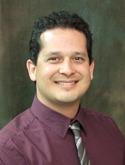Program Information
Diagnostic Imaging Research Using Decedents as a Proxy for the Living: Are Radiation Dosimetry and Tissue Property Measurements Affected by Post-Mortem Changes?
D Sandoval1*, W Weber2 , D Melo2 , N Adolphi3 , G Hatch3 , P Heintz1 , (1) Department of Radiology University of New Mexico School of Medicine, Albuquerque, NM, (2) Lovelace Respiratory Research Institute, Albuquerque, New Mexico, (3) Radiology-Pathology Center for Forensic Imaging, University of New Mexico School of Medicine, Albuquerque, New Mexico,
Presentations
SU-C-12A-4 Sunday 1:00PM - 1:55PM Room: 12APurpose:
Radiation dose (RD) from diagnostic imaging is a growing public health concern. Implanting dosimeters is a more accurate way to assess organ dose, relative to commonly used mathematical estimations. However, performing accurate dosimetry using live subjects is hindered by patient motion and safety considerations, which limit the RD and placement of implanted dosimeters. Performing multiple scans on the same subject would be the ideal way to assess the impact of dose reduction on image quality; however, performing multiple non-standard-of-care scans on live subjects for dosimetry and image quality measurements is generally prohibited by IRB committees. Our objective is to assess whether RD and tissue property (TP) measurements in post-mortem (PM) subjects are sufficiently similar to those in live subjects to justify the use of deceased subjects in future dosimetry and image quality studies.
Methods:
4 MOSFET radiation dosimeters were placed enterically in each subject (2 sedated Rhesus Macaques) to measure the RD at 4 levels (carina, lung, heart, and liver) during CT scanning. The CT protocol was performed ante-mortem (AM) and 2 and 3 hours PM. For TP analysis, additional scans were taken at 24 hours PM. To compare AM and PM TP, regions-of-interest were drawn on selected organs and the average CT density with standard deviation (in units of HU) were taken; additionally, visual comparisons of images were made at each PM interval.
Results:
No significant difference was observed in 8 of 9 measurements comparing AM and PM RD. Only one measurement (liver of the first subject) showed a significant difference (7% lower on PM measurement), possibly due to subject re-positioning. Initial TP visual and quantitative analyses show little to no change PM.
Conclusion:
Our results suggest that realistic radiation dosimetry and image quality measurements based on tissue properties can be performed reliably on recently deceased subjects.
Contact Email:


